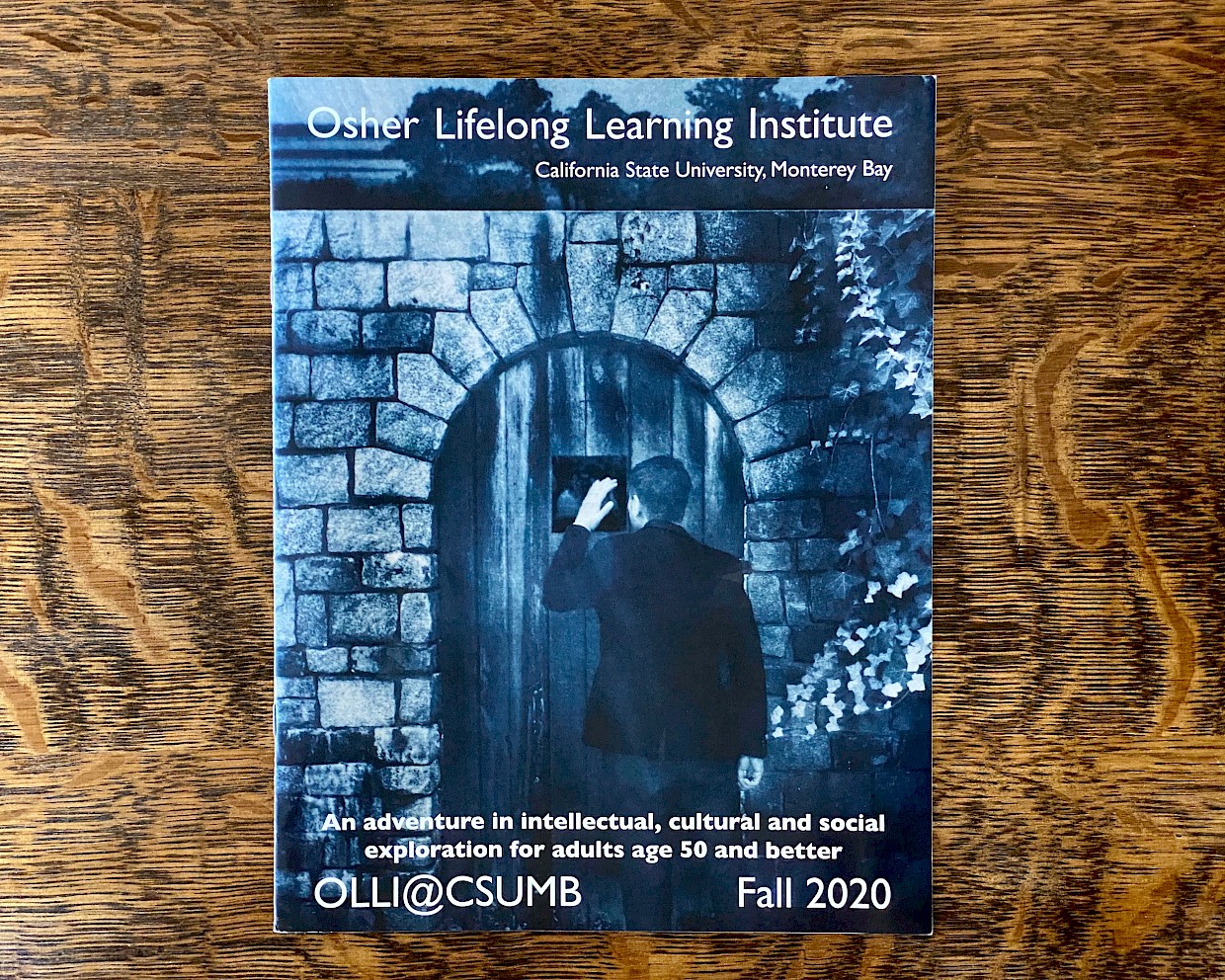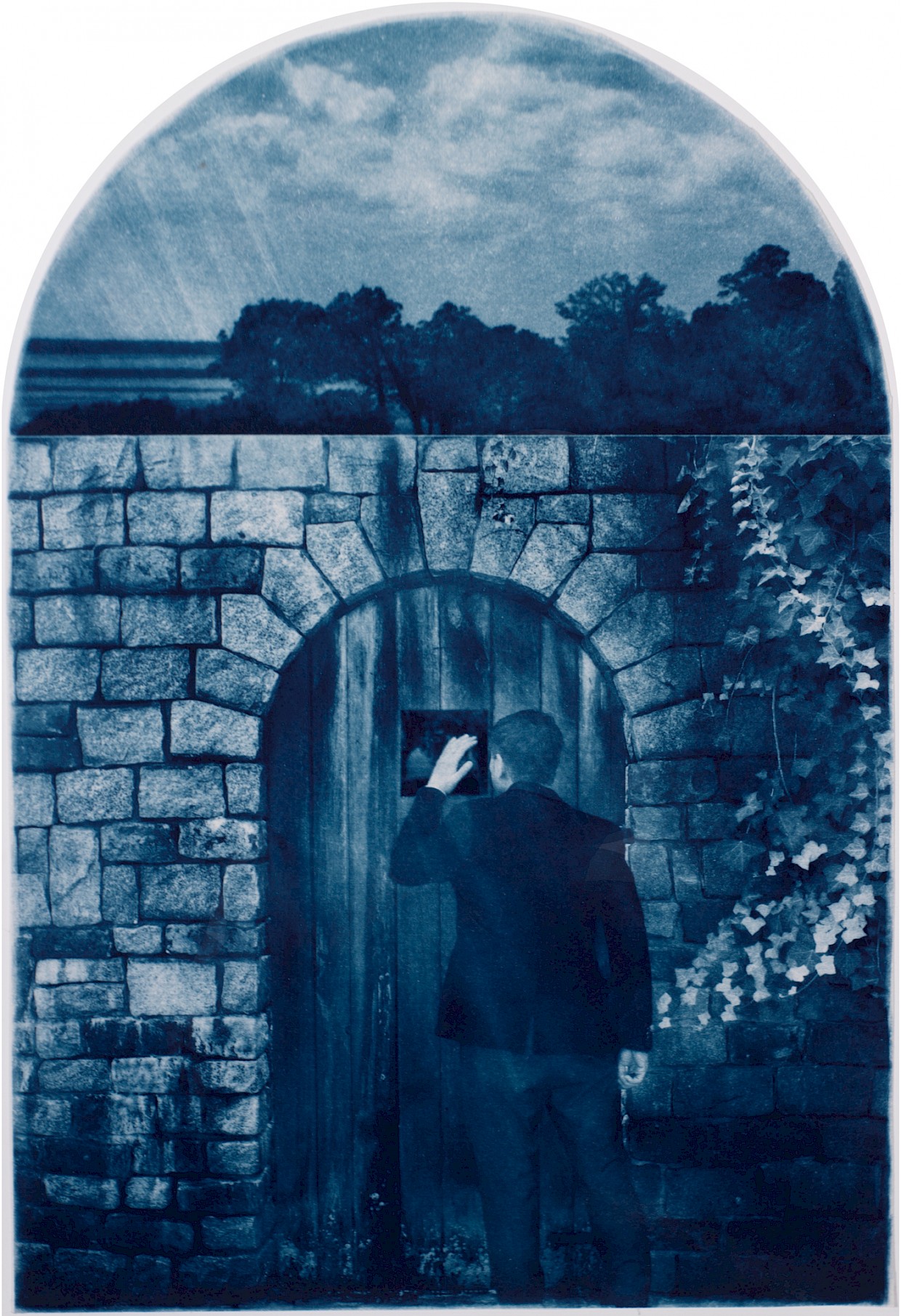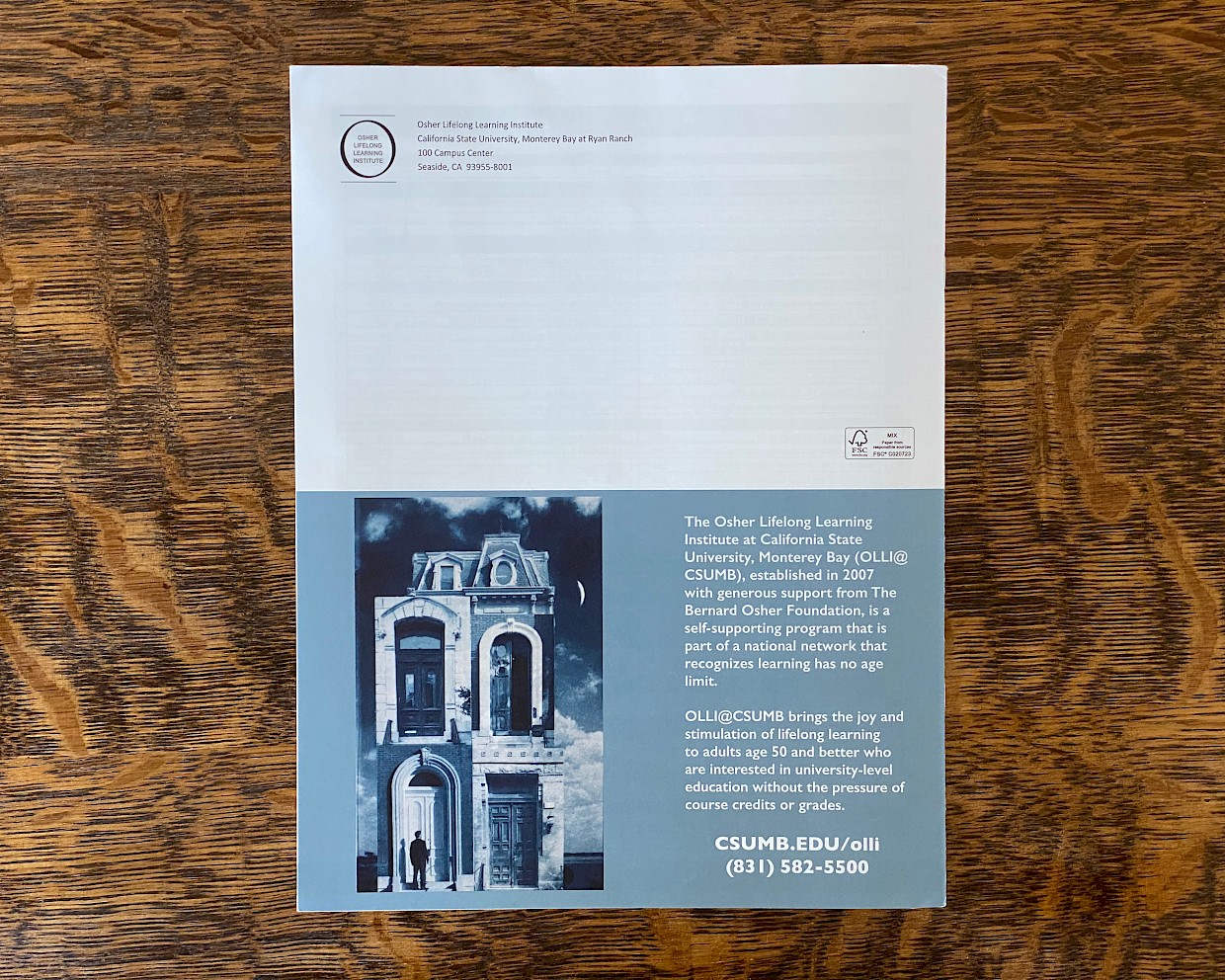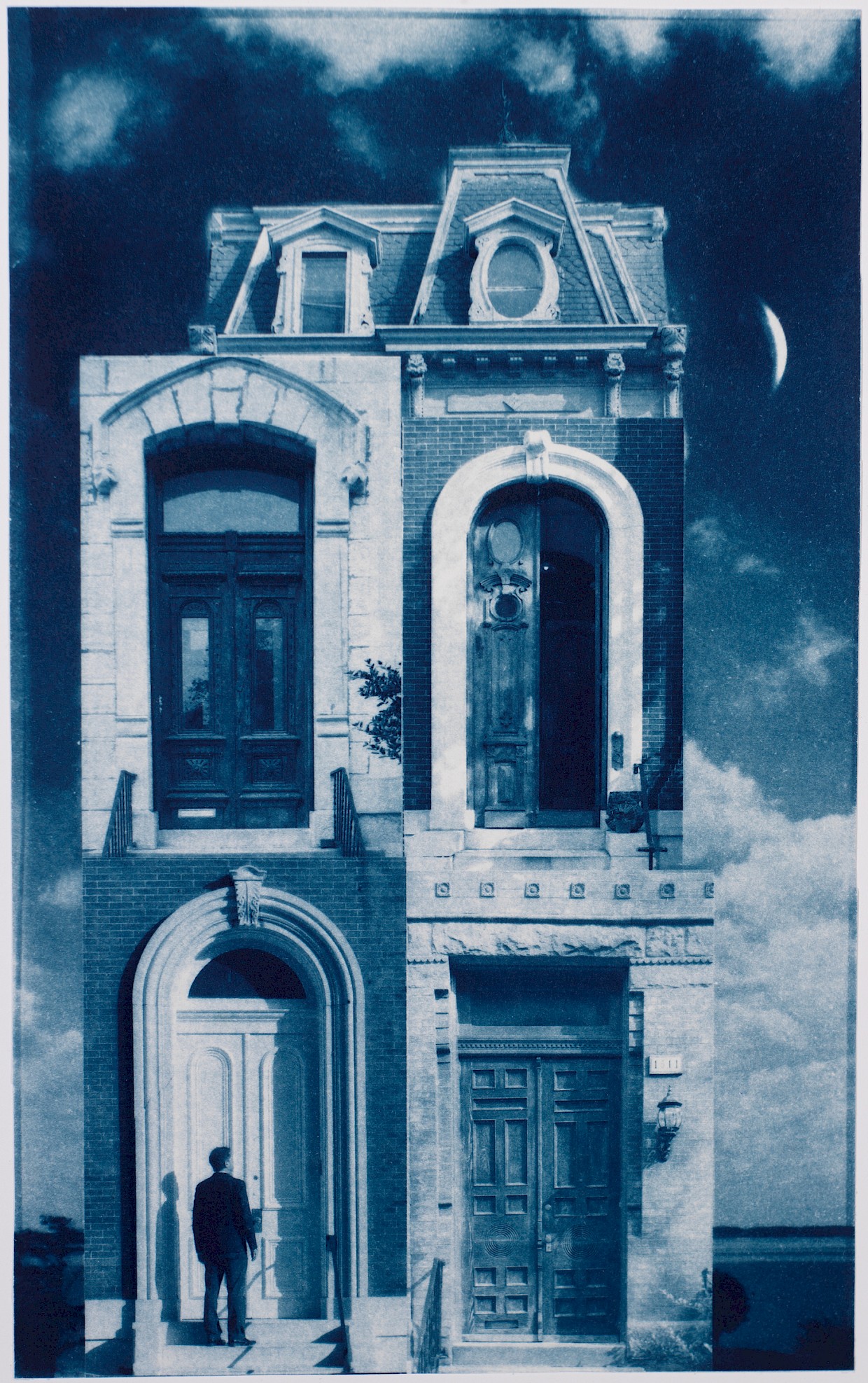How to Make a Decision
Aug 27, 2020 / The Twelve Mysteries / carl jung / james hollis / art exhibitions by year / synchronicity

I have some art news! My cyanotype artwork graced the catalog cover of Osher Lifelong Learning Institute (OLLI) based out of California State University! A big thank you to Ann Jastrab, Executive Director of the Center for Photographic Art, for recommending my work to OLLI.
This catalog is beautifully printed and features the cyanotype art of other artists like Christina Z. Anderson, Brenton Hamilton, Heidi Kirkpatrick, Robert Langham III, Emma Powell, and Brian Taylor. If you want to see amazing cyanotype work, download a pdf copy of the catalog. Also, why not sign up for a continuing education course? The classes will be through Zoom this fall, so anyone can join! Their offerings run the gamut of art, history, literature, writing, and current events.
For the front cover, OLLI chose The Unremembered Gate—an image I created in 2012. Reflecting on this image, I realize I’ve changed a lot. For example, the way I approach choices now is more “grown-up” than before. In this article, I explain what I mean by recounting my journey and referencing the ideas of psychoanalyst Carl Jung. If you’re deciding between two jobs, two choices, or two life paths, I hope this article helps!

Buy a Print
or License image
My Journey from Accountant to Artist
For many years, I wrestled with how to choose a career. Am I an accountant or an artist? I had trained as an accountant, but I always felt I was on the wrong road.
I decided to go back to school in 2010 to pursue a Master of Fine Arts (MFA) degree while working full time as an accountant. It was during this MFA degree that I created The Unremembered Gate, part of the A Million Suns series that tells a story of an everyman searching for his future.
In the series’ images, the protagonist always faces a choice: forward/backward, right/left, opening/closing, etc.There are ideas like identity, spirituality, and mythology in the images, but for this article, I focus on choice. Collage and layering further emphasize the idea of choice in the final artwork.
After graduating in 2014, I still couldn’t decide. Part of the problem was financial: I couldn’t see how I could support myself with art. The other problem was the fear of the unknown. What if no one bought or looked at my art? It would be humiliating! As a result, I ended up not choosing. I continued to work as an accountant from 2014-2019. I felt ashamed about my inability to choose. (This is what was going through my head. In a way, I did make a choice—by not making a choice.)
In 2019, however, I quit my job to focus on art. How did I finally decide when many years before I couldn’t? Well, there were two developments. First, the Financial Independence Retire Early (FIRE) movement inspired me. Second, my company started reducing its workforce.
Hold the Tension of the Opposites
Looking back now, I approached choices in a deterministic and logical manner. In my mind, there were only two choices. I had tunnel vision where the world was either/or. I made do with the hybrid answer of “accountant / artist.”
Recently though, I came across a Carl Jung quote that changed my perception of and made me feel better about what I had done. In the 1950s, people asked Jung about the likelihood of a nuclear war arising from the Cold War:
“I think it depends on how many people can stand the tension of the opposites in themselves. If enough can do so, I think the situation will just hold, and we shall be able to creep around innumerable threats and thus avoid the worst catastrophe of all: the final clash of opposites in an atomic war. But if there are not enough and such a war should break out, I am afraid it would inevitably mean the end of our civilization as so many civilizations have ended in the past but on a smaller scale.”
— as remembered by Barbara Hannah, Jung: His Life and Work A Biographical Memoir, p129
Unknowingly, what I was doing was “holding the tension of opposites.” According to Jung, the mature thing to do is to hold this tension until a third option appears. Psychoanalyst James Hollis elucidates on Jung’s recommendation:
“As Jung said, holding the tension of opposites until “the third” appears is the only way to work our way through to the choice that is right for us. The “third” is what that choice means for the psychospiritual development of the choosing individual, especially when called before large opposites in their life. And always, the willingness to accept the consequences of one’s choice is the hallmark of a mature decision.”
— James Hollis, Living Between Worlds: Finding Personal Resilience in Changing Times, p69
What was my third option? It was the idea of “retiring.” That simply never occurred to me as it was illogical. According to Jung, “the logic of the intellect usually fails, for in a logical antithesis there is no third [option]” (Carl Jung CW 14:705).
Now to be clear, I don’t recommend that if you’re faced with deciding between career A versus career B, that the answer is to retire. That may or may not work for you. As I wrote in Retiring Early To Do Art Full Time, through habit and luck more than foresight, I discovered I could quit my job. This leads me to the next point.


Buy a Print
or License image
Outgrow the Problem
If you’re conflicted about two alternatives, perhaps the answer is to keep learning and going about life, and at some point, you simply outgrow the problem.
“We don’t so much solve our problems as we outgrow them. We add capacities and experiences that eventually make us bigger than the problems.”
—Carl Jung
In a way, that’s what happened to me. I realized that the problem I had all those years, “Am I an accountant or artist?” no longer mattered. I had outgrown the problem! The financial implications lost its perceived danger. The prospect of no one buying or paying attention to my art no longer terrified me.
Apply Jung’s Approach Everywhere
To summarize, if you are stuck and can’t decide after weighing the pros and cons of the two options, then perhaps the answer is not to make a choice. Instead, either hold the tension of opposites until a third option appears or enlarge your life until you outgrow the problem. These alternatives don’t make you weak or a loser. They may be the most mature things to do. It’s a change in mindset that I applied retroactively in my life, and made me feel better about my meandering journey. This mindset may be useful in your life.
“Holding the tension of opposites until a third option appears” can be applied in many areas, not just in how to choose a career. Apply it to questions relating to spirituality, life direction, and life purpose. These areas gestate over a long period of time, and so Jung’s approach will help.
Also, try using this idea to survive the political and social upheavals during the coronavirus pandemic. In the United States, for example, the “tensions of opposites” between Republicans and Democrats feel endless. What might a third option look like, which is usually an unexpected synthesis of tensions? I don’t know the answer, but I hope that when that transcendent third option appears, enough Americans unite behind it.



